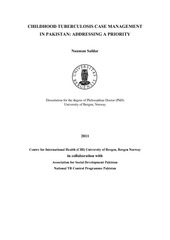| dc.contributor.author | Safdar, Nauman | en_US |
| dc.date.accessioned | 2011-09-16T13:05:47Z | |
| dc.date.available | 2011-09-16T13:05:47Z | |
| dc.date.issued | 2011-06-24 | eng |
| dc.identifier.isbn | 978-82-308-1792-6 (print version) | en_US |
| dc.identifier.uri | https://hdl.handle.net/1956/5016 | |
| dc.description.abstract | Childhood tuberculosis is considered a major cause of morbidity and mortality in high burden TB countries. It has had a low priority for research and development globally and was not given much attention in the past on ways and means to operationalize the case management strategies within the context of National TB Control Programmes. The current thesis focuses on various cohorts of childhood TB and audit of the case management practices within the routine national TB control programme of Pakistan. The thesis also documents the lessons learned during this research and development. Our initial retrospective cohorts were based on the review of patient records, focused on the case notification, treatment outcomes and case management practices of patients registered during two complete years 2004 and 2005, when NTP had no particular emphasis on childhood TB and had recently expanded the DOTS strategy for adults. These results we compared with those of patients registered during 2006 and 2007, when new NTP childhood TB policy guidelines were implemented. Based on this we developed and piloted the intervention ‘childhood TB deskguide and structured monitoring’ with a purpose to increase case notification and improve treatment outcomes. This intervention was implemented in one district during the year 2008 and compared with the same district in 2007(pre-intervention) and we also compared the intervention district with the two control districts in 2008 (all postintervention). After the NTP introduced their childhood TB policy guidelines there was an increase in case notification (p<0.05) from 1.4/100 000 (95% confidence interval [CI] 1.0-1.7) to 5.2/100 000 (95% CI 4.9-5.6) but the treatment outcomes varied across the sites. Paediatricians also began to follow parts of the national policy guidelines for management of childhood TB including the use of the tuberculin skin test, chest radiography and score chart, but the record keeping of case management practices including diagnosis and treatment outcomes was inadequate. Later, in the district with the intervention package of childhood TB ‘deskguide and structured monitoring’ there was an increase in case notification from 17 cases (0.6/100 000) before to 37 cases (1.3/100 000) after the intervention. During the same period control District A had a reduction of 6% and control District B had an increase of 30%. There were also better outcomes (treatment success 100% compared to 18% in control district A and 72% in control district B) and it helped standardize the process of care and augmented the NTP policy. In conclusion, our results show that the management of childhood TB is possible under routine National TB Control Programme circumstances in Pakistan. However, there is a need to refine the intervention package and develop a training package for the paediatricians, clinicians and paramedics who are to be involved in the scale-up process for childhood TB case management. | en_US |
| dc.language.iso | eng | eng |
| dc.publisher | The University of Bergen | eng |
| dc.relation.haspart | Paper I: N.Safdar, S.G.Hinderaker, N.A. Baloch, D.Enarson, M.A. Khan, O.Mørkve. Diagnosis and outcome of childhood tuberculosis: implementing public health policy in three districts of Pakistan. International Journal of Tuberculosis and Lung Disease, 2010, 14(7):872-877. Full text not available in BORA due to publisher restrictions. The article is available at: <a href="http://www.ingentaconnect.com/content/iuatld/ijtld/2010/00000014/00000007/art00014" target="_blank"> http://www.ingentaconnect.com/content/iuatld/ijtld/2010/00000014/00000007/art00014</a> | en_US |
| dc.relation.haspart | Paper II: N.Safdar, S.G.Hinderaker, N.A. Baloch, D.Enarson, M.A. Khan, O.Mørkve. Are children with tuberculosis in Pakistan managed according to National programme policy guidelines? A study from 3 districts in Punjab. BMC Research Notes, 2010, 3:324. The article is available in BORA: <a href="http://hdl.handle.net/1956/5014" target="_blank"> http://hdl.handle.net/1956/5014</a> | en_US |
| dc.relation.haspart | Paper III: N.Safdar, S.G.Hinderaker, N.A. Baloch, D.Enarson, M.A. Khan, O.Mørkve. Childhood tuberculosis deskguide and monitoring: An intervention to improve case management in Pakistan. BMC Health Services Research, 2011, 11:187. The article is available in BORA: <a href="http://hdl.handle.net/1956/5015" target="_blank">http://hdl.handle.net/1956/5015</a> | en_US |
| dc.relation.haspart | Paper IV: N.Safdar, S.G.Hinderaker, N.A. Baloch, D.Enarson, M.A. Khan, O.Mørkve. Translating childhood tuberculosis case management research into operational policies [Notes from the field]. International Journal of Tuberculosis and Lung Disease, 2011, 15(8): 1127-1130. Full text not available in BORA due to publisher restrictions. The article is available at: <a href="http://dx.doi.org/10.5588/ijtld.10.0700" target="_blank"> http://dx.doi.org/10.5588/ijtld.10.0700</a> | en_US |
| dc.title | Childhood tuberculosis case management in Pakistan: Addressing a priority | en_US |
| dc.type | Doctoral thesis | |
| dc.rights.holder | Copyright the author. All rights reserved | |
| dc.subject.nsi | VDP::Medical disciplines: 700::Clinical medical disciplines: 750::Lung diseases: 777 | eng |

